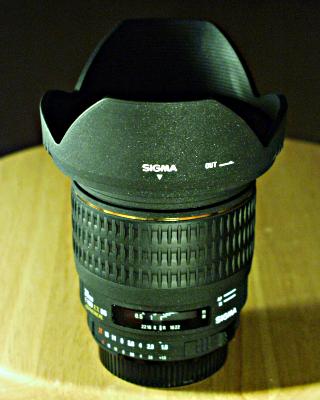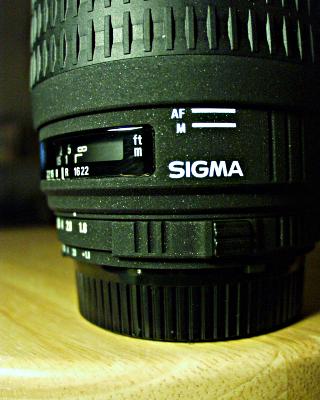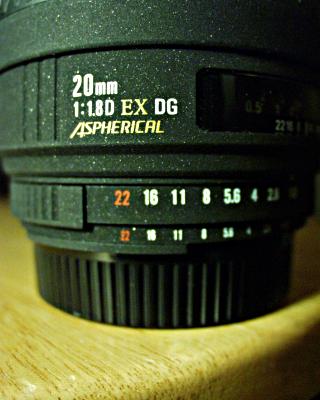Sigma 20mm f/1.8 D EX DG Aspherical Lens

Like the rest of Sigma's EX-line of profession lenses, the Sigma 20mm f/1.8 D EX DG Aspherical Lens has a solid build, a cool and rugged finish, a non-rotating front, and a metal lens mount.
The front filter thread on this lens is 82mm, which is 5mm bigger than the 77mm filter threads that is standard on most professional lenses. I see many lens manufacturers starting to standardize on 82min threads for wide-angle lenses. So, I wished that I had standardized on 82mm filters as well, rather than 77mm.
I really looked forward to using this fixed focal-length wide-angle lens. It's the first lens I got my hands on that is specifically made for digital single-lens-reflex (DSLR) cameras; the DG designation. With the popularity of digital cameras, many manufacturers flocked to build "digital" lenses, hoping to capitalize on the digital craze. I wanted to find out whether this is all hype or does it really make a difference.
The minimum focus distance on this lens at 20 cm (7.9 inches) is quite remarkable. At this distance, the lens has a maximum magnification of 1:4, which almost matched the 0.28x maximum magnification on the Canon EF-S 18-55mm f/3.5-5.6 lens at 55mm (see my review article elsewhere on this site).
Include with this lens are front and rear lens caps, a flower-shaped lens hood, and a gray padded carrying pouch. The carrying pouch has built-in strap for your belt and two sealing systems. One is a quick velcro strap, the other is a zipper. You can use the velcro strap by itself to get your lens out quickly, or use both the zipper and the Velcro strap to be more secure.

The Sigma 20mm f/1.8 D EX DG Aspherical Lens has a clutch-like system for switch between AF and MF modes. The system is very similar to the Sigma 105mm f/2.8 EX macro lens I reviewed previously. You push the manual focus ring forward to disengage the focus ring for auto-focusing. For manual focusing, you pull it toward you to engage the clutch. When the ring is set to AF, you can rotate the focusing ring all you want, you won't change the focus on the lens. When the lens is auto-focusing, it also doesn't effect the position of the manual-focusing ring. The manual focus ring is wide so there is no chance that you'll miss it in operation.
I happened to have the Nikon version of this lens, but I don't have any Nikon SLR cameras. So I could not test the AF capability of this lens. I mounted this lens to my Canon EOS D30 camera via a Novoflex adapter (see my review elsewhere on this site). With a 1.6x magnification, this lens acted as a 32mm lens on the D30.

The nice thing about using a Nikon lens on Canon EOS cameras is that I get the play with the aperture ring. The aperture ring is really thin, indented, and right next to the camera body. Therefore, it might be hard to get to for someone with large fingers. I was able to adjust it using the side of my thumb and index finger. The aperture ring is easy to turn. Each setting is notchy, so that there is no question which aperture the lens has been set to. All of the aperture indicators are white, exception for f/22 in red. It indicates that when the lens is set to f/22, the aperture ring can be locked with a small switch on the aperture ring. I suspect that some Nikon SLR cameras can set the aperture electronically through the camera body. What is surprising, though, is that the lens locks it at the smallest aperture, rather than wide-open. It makes me wonder if the Nikon cameras have to waste electrical energy to keep the aperture wide-open for viewing through the viewfinder and for focusing.
Is DG Lens Just a Marketing Gimmick?
Sigma's DG lenses are made for digital SLR cameras. On its web site, Sigma claims that "[DG lenses] are large-aperture lenses with wide angles and short minimum focusing distances. With an abundance of peripheral illumination, they are ideal lenses for Digital SLR Cameras whilst retaining suitability for traditional 35mm SLRs." Hmmmm . . . a lot of words, but hard to comprehend their meaning.
Let's try to break these phrases down and see if we can fully understand its meaning. "Large-aperture" means f/1.8. "Wide angles" means 20mm. "Short minimum focusing distance" is always a good thing. Isn't the "abundance of peripheral illumination" phrase just a repeat of "large-aperture"? The last sentence says that the lens is made for digital cameras, but still works with 35mm cameras. Everything mentioned seems to be good quality for all cameras, whether digital or film. Sounds like a lot of marketing talk to me.
Related Links
- Sigma 20mm f/1.8 EX DG Aspherical Lens for Canon SLR Cameras - Amazon User Reviews
- Sigma 20mm f/1.8 EX DG Aspherical Lens for Konica Minolta SLR Cameras - Amazon User Reviews
- Sigma 20mm f/1.8 EX DG Aspherical Lens for Nikon SLR Cameras - Amazon User Reviews
- Sigma 20mm f/1.8 EX DG Aspherical Lens for Pentax SLR Cameras - Amazon User Reviews
- Sigma 20mm f/1.8 EX DG Aspherical Lens for Sigma SLR Cameras - Amazon User Reviews
- SIGMA LENS 20mm f/1.8 EX DG Aspherical RF Wide Angle Lens - Amazon User Reviews
$10000-above
$5000-$9999
$2000-$4999
$1000-$1999
$500-$999
$200-$499
$100-$199
$50-$99
$25-$49
$0-$24
Gift Certificate

